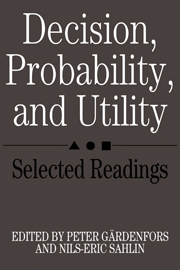Book contents
- Frontmatter
- Contents
- List of contributors
- Preface
- 1 Introduction: Bayesian decision theory – foundations and problems
- Part I Foundations of Bayesian decision theory
- Part II Conceptualization of probability and utility
- Part III Questionable rules of rationality
- Part IV Unreliable probabilities
- Part V Causal decision theory
- 17 Counterfactuals and two kinds of expected utility
- 18 Causal decision theory
- 19 Ratifiability and stability
- References
- Name index
- Subject index
19 - Ratifiability and stability
Published online by Cambridge University Press: 05 June 2012
- Frontmatter
- Contents
- List of contributors
- Preface
- 1 Introduction: Bayesian decision theory – foundations and problems
- Part I Foundations of Bayesian decision theory
- Part II Conceptualization of probability and utility
- Part III Questionable rules of rationality
- Part IV Unreliable probabilities
- Part V Causal decision theory
- 17 Counterfactuals and two kinds of expected utility
- 18 Causal decision theory
- 19 Ratifiability and stability
- References
- Name index
- Subject index
Summary
Background
In this paper I am going to discuss Richard Jeffrey's maxim of ratifiability – a maxim that enjoins the agent to make decisions that he can ratify once he has made them. (Cf. the second edition of The Logic of Decision, Jeffrey, 1983. See also Jeffrey, 1981.) I shall also consider a number of decision-theoretical proposals according to which ratifiability or “stability”, which is a closely related property, constitutes at least a necessary, if not a sufficient, condition on rational options. I want to oppose this recent trend. I am going to suggest that stability considerations are, in a sense, irrelevant. They do not provide the agent with reasons for or against different options. The present paper is a successor to Rabinowicz (1985). There I suggested that stability considerations, while not being decisive, should at least be given some weight in decision-making – that they at least provide the agent with some reasons to act. I don't believe this any longer.
First, a short background. In the first edition of his Logic of Decision (1965), Jeffrey advised us to choose so as to maximise the expected desirability of our actions. The expected desirability of an action was defined as the weighted sum of that action's desirability-values under different states (or, to use Jeffrey's own terminology, under different possible “conditions”). As his weights, Jeffrey used the conditional probabilities for the different states given the action in question.
- Type
- Chapter
- Information
- Decision, Probability and UtilitySelected Readings, pp. 406 - 425Publisher: Cambridge University PressPrint publication year: 1988
- 6
- Cited by



